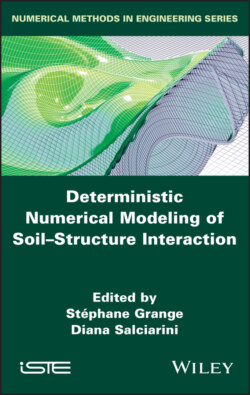Читать книгу Deterministic Numerical Modeling of Soil Structure Interaction - Группа авторов - Страница 9
Оглавление
Introduction
The deterministic numerical modeling of Soil–Structure Interaction (SSI) uses the tools of Mechanics, and of their transposition, according to the methods of the numerical discretization. An SSI analysis should take into account the differences between the properties of the soil and the structure, possibly leading to local relative displacements. In addition, the presence of water enforces to consider the interaction on the hydro-mechanical framework, involving pore pressures and fluid flow.
Non-deterministic methods, making use of artificial intelligence and progressive learning, are not considered here.
The geotechnical works are usually designed referring to the following three situations:
1) The pseudo-static case: where the loadings are nearly time independent (a small number of cycles are accepted).
2) The cyclic case: involving a large number of slow cycles (slow versus the time scales of any physical phenomena involved).
3) The dynamic (mostly seismic) case: where inertia forces are taken into account.
In the pseudo-static and cyclic cases, the SSI is defined from a local point of view, whereas in dynamic conditions it is examined from a more global angle. The soil–structure interfaces, transfer zones of the loads acting between soil and structure, and often zones of large localized deformations have a significant importance. Special strategies and experimental characterization tests have been developed for describing them.
This volume gives an overview on the main modeling methods developed in geotechnical engineering in order to describe the SSI in various situations:
– The classical and well-known finite element method (FEM) using interface or contact elements available for coupled hydro-mechanical problems and in which the local plastic energy dissipation contributes to the classical global damping.
– The distinct element method (DEM) in which the contact zones between soil and structure are described by local adapted interaction laws.
– The finite difference method (FDM) using explicit algorithm in which interface or contact elements are available and straightforward for coupled hydro-mechanical, highly nonlinear with high deformation and dynamic problems.
– The more recent approaches based on the macro-element concept and generalized variables in an incremental form available in static and dynamic situations, where a large volume of soil underlying and surrounding the-structure is represented by a small number of degrees of freedom. This method could be considered as an improved extension of the stiffness coefficient methods known for the piles as the t-z and p-y curves.
– The seismology approach with inertia and viscous equivalent damping forces, in which the SSI is developed between several structures (like buildings in a town) using the notion of meta-materials. This point of view is especially useful when analyzing the movement of the buildings induced by a seismic event at the scale of a town.
